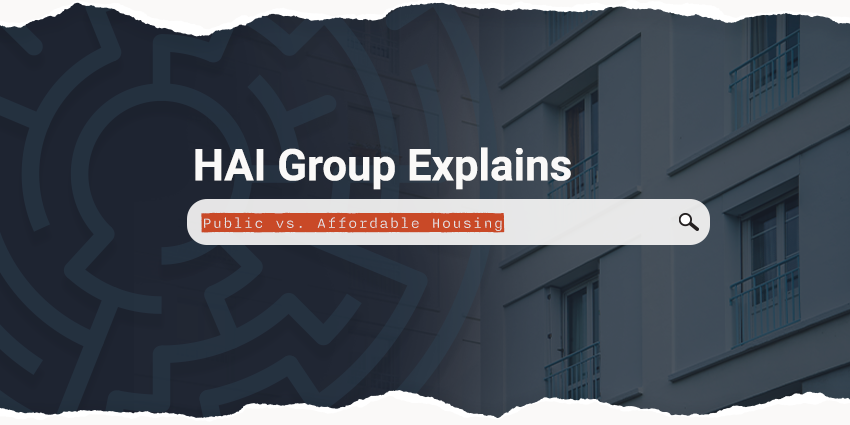Affordable housing organizations planning significant redevelopment or renovation projects must partner with contractors to accomplish the task. So, how do you select qualified contractors, monitor their work, and ensure your organization, as the project owner, doesn't expose itself to unnecessary risks?
This article covers the basics of working with contractors, providing methods to help transfer, avoid, and reduce the risks involved in construction projects. Whether you're a seasoned professional or a newcomer to project management, these essential guidelines will empower you to navigate the intricate landscape of working with contractors effectively.
To learn more about working with contractors, view this HAI Group Online Training course.
Assembling the project team
If a housing organization initiates a construction project on one of its properties, the organization is considered the project owner. The project team starts with the owner, said Mathew Ross, a partner with law firm Wilson Elser who focuses on the defense of construction accident claims and other high-exposure premises liability claims.
The owner must first determine the scope of work (e.g., new construction, renovation, redevelopment) to put the proper project team together. A well-defined scope of work can help avoid problems down the line. In most cases, the owner will need an architect to design the project and develop plans, Ross said.
A construction manager—also referred to as an owner’s representative—is another vital team member (smaller projects may not warrant a construction manager).
“That construction manager acts as the liaison between the owner and the general contractor,” Ross said.
The general contractor is responsible for construction activities. For example, if a housing organization plans three new residential buildings, the general contractor builds them. But the general contractor doesn’t handle all of the physical work—that’s where subcontractors come in.
Subcontractors specialize in trades like electrical, carpentry, plumbing, painting, and HVAC. The general contractor coordinates and manages subcontractors while ensuring construction is completed in a timely and safe manner in accordance with the owner’s plans.
There are contractual agreements between multiple parties on the project team. The housing organization or project owner has a contract with the architect, construction manager, and general contractor. Meanwhile, the general contractor has separate contracts with each subcontractor.
Corleto said some agreements could, by reference, include language from others. For example, a subcontractor’s agreement with the general contractor may incorporate aspects of the general contractor’s agreement with the owner, including project drawings and specifications.
The project scope of work is often a requirement for builders’ risk insurance coverage, as are partnership agreements with lenders or development firms. A copy of the general contractor agreement is also a typical insurance coverage requirement.
Contract management
A contract is an agreement for one entity to provide a good or a service, and another entity to pay for that good or service, said Anthony Corleto, HAI Group's chief legal and compliance officer.
A contract can be a simple oral or written agreement. In the case of construction projects, contracts are fairly long agreements, noted Corleto, who has experience representing housing organizations. A contractor is a person or entity that performs a service according to the agreed-upon contract.
 The American Institute of Architects (AIA) offers templated contracts for just about every construction scenario.
The American Institute of Architects (AIA) offers templated contracts for just about every construction scenario.
Corleto said the number and type of contracts a housing organization has for a given project depend on the project team it assembles.
Housing organizations undergoing construction projects should have a designated employee or department responsible for contract management. In many cases, a lawyer is involved, but a legal background isn’t a prerequisite for managing contracts, Corleto noted.
The person or team handling contract management should be involved in the construction project early, right when it is bid out. The management process is ongoing and includes:
- reviewing and awarding bids;
- collecting contracts and proof of insurance from each participant of the project; and
- following up each step of the way to make sure everything conforms.
Leadership should also empower those in charge of contract management to check with state agencies, insurance companies, and licensing authorities to confirm the necessary details.
General contractor qualifications
While project experience is an important qualification for a general contractor, creditworthiness and ownership of assets are also critical. Why do finances matter? Because the project owner doesn’t pay subcontractors directly. The owner pays the general contractor, which pays the subcontractors it has hired.
“You’re going to trust that general contractor with a sum of money, and trust that the general contractor will use the money you give them to pay the subcontractors,” Corleto said.
If a general contractor is in financial trouble, the contractor could potentially use money from their current job to pay subcontractors from a prior job. If subcontractors from the current job aren’t paid in time, it could result in costly project delays, disputes, and lawsuits.
Projects financed by the U.S. Department of Housing and Urban Development (HUD) have specific requirements for hiring a general contractor (e.g., bid specifications, insurance requirements, performance, and payment bonds). The general contractor should be licensed according to state law, no matter the funding source.
“That’s something you can check with the licensing agency in your state,” Corleto noted. “Don’t just accept a piece of paper. Look it up; call the agency.”
All contractors involved in the project, including subcontractors, must also be insured according to owner and lender requirements, Corleto added. Requirements usually include adequate general liability, workers' compensation, and property coverage (builders' risk) limits to ensure that there's money to recover and replace losses if a peril occurs.
Throughout the project, it’s vital to track coverage to ensure contractors are maintaining coverage. Housing organizations can request to review a contractor’s certificate of insurance (COI), which is issued with every insurance policy.
The most common COI, issued by the ACORD organization, is called an ACORD 25, Corleto said. These certificates can and have been faked.

“You might think you have coverage because a COI is in place, but in fact, there was no COI issued, and there’s policy or coverage as expected,” he said.
Corleto offered the following advice to ensure the COI is legitimate:
-
Review the lower-left corner of the ACORD 25 certificate to ensure the legend is listed near where you would expect to see the copyright notice.
-
The ACORD 25 certificate lists the insurance company name. Ensure the name matches the insurance company initially identified for the project.
-
Check for spelling issues and suspicious formatting. For example, insurance terms like "broad form" are usually spelled out, not abbreviated. In one instance, a contractor shortened the term to "bro form" on a fake COI.
Structuring contracts to transfer risk
Bond requirements
Housing organizations should negotiate contracts requiring general contractors' bonds for performance and payment. A bond is a risk transfer agreement between the surety company, the entity requiring the bond (the housing organization/owner in this case), and the principal (the general contractor).
Performance Bond: Guarantees that if the general contractor is unable to complete its contract, the surety company will provide funding to the housing organization to get the job done. |
Payment Bond: Helps housing organizations avoid getting entangled in payment disputes between general contractors and subcontractors. A payment bond ensures subcontractors are paid in full if the general contractor cannot fulfill its payment obligation. If subcontractors aren’t paid, and no payment bond is in place, the subcontractor could file a lien (a legal claim against property used as collateral for debt) against the housing organization to obtain payment. The bond ensures no liens are filed against any housing organization properties. |
Additional insured status
Housing organizations should also mandate that they're named an additional insured on all contractor general liability insurance policies. In the event of a lawsuit by a third party, these policies will defend the housing organization, too.
“That risk won’t come to [the housing organization] directly; it will be managed by the contractor’s insurance policy,” Corleto said.
A certificate of insurance (COI) is typically issued as proof of coverage when a policy is issued. It identifies the primary insured (in this case, the general contractor), the project, and ideally, the housing organization as the project’s owner. As additional insured, housing organizations are entitled to receive advanced notice of changes to the policy, such as a cancellation due to nonpayment.
Housing organizations should carefully review the general contractor's liability policy terms. An endorsement should show the housing organization (or project owner) as an additional insured. Look out for limitations placed on the coverage afforded to the housing organization as an additional insured.
“As the owner, you rely on others to get the work done,” Corleto said. “You don’t want to accept an additional insured clause limiting your status to being covered on the general contractor’s policy only for your acts or omissions. You want the broadest form of additional insured coverage available so it would not be limited with those terms.”
Contractual indemnification
Contractual indemnification is another concept that helps shift liability away from housing organizations. Ross said the project owner must negotiate the best possible indemnity provisions in its agreement with the general contractor.
In simple terms, contractual indemnification provisions are designed to ensure the general contractor will defend, hold harmless, and indemnify the project owner (housing organization) for any personal injury or property damage arising from the general contractor’s work.
The housing organization should also ensure that the general contractor has indemnity language in its agreements with subcontractors. Ross said this language protects the general contractor and the owner, and any owner's representatives, such as the construction manager or architect.
Ross noted that some jurisdictions treat contractual indemnification provisions differently, especially with a construction-related contract. There are narrow, intermediate, and broad indemnification provisions.
The narrowest form of indemnity is when the general contractor or subcontractor agrees to indemnify the project owner only to the extent of the subcontractor’s fault. For example, a plumbing subcontractor working on a project slips on a puddle of liquid and is injured. The injured subcontractor sues the project owner and general contractor, alleging negligence. Based on the narrow indemnity clause, the burden is on the owner and general contractor to prove that the subcontractor was at fault.

Broader forms of indemnity take the burden off the owner and general contractor to prove that the plumber was negligent. Ross said it's prudent for housing organizations to have at least an intermediate or middle-ground clause in contracts that indemnify the defendant and hold the housing organization harmless.
Housing organizations should attempt to obtain a copy of all insurance policies in which they are named an additional insured. Ross said it’s critical to check for discrepancies between insurance policies and contracts.
For instance, while the contract between the general contractor and subcontractor may have broad indemnity language benefitting the housing organization, the subcontractor’s insurance policy may have limiting language that says the owner is only an additional insured to the extent that the subcontractor is found to be actively at fault or negligent for an incident. The broad indemnity doesn’t align with the limiting additional insured language and can lead to a dispute in the event of an incident.
“It’s important to resolve that discrepancy if at all possible,” Ross said.
Alternative dispute resolution
Housing organizations should structure contracts to include a clause for alternative dispute resolution (ADR), which refers to arbitration and mediation.
“These are things you can do to resolve a dispute without having to go to court,” Corleto said.
The clause should indicate that in the event of a dispute, all parties will enter mediation, which is an open negotiation process mediated by an unbiased third party. If mediation doesn’t resolve the issue, the matter moves to arbitration, a more formal process where an arbitrator will hear all sides of the dispute and announce a decision. Arbitration differs from a court proceeding in that the project owner engages and pays the arbitrator and decides on schedule.
“Make sure there’s a clause in contracts that specify engaging in mediation and arbitration before going to court since [court] is an expensive and lengthy process and you have less control over the outcome,” Corleto said. “With mediation, you decide the outcome. With arbitration, you have more control over the outcome.”
Tendering claims as a risk management tool
Any injury on the job site carries the potential of a lawsuit. Housing organizations, as project owners, have a powerful risk management tool they can deploy once they have investigated the incident, Ross said. That’s filing a claim or notifying the relevant insurer of a potential claim as soon as possible (referred to as "tendering a claim" in insurance jargon).

“This gives the owner the immediate opportunity to try and shift the focus of the lawsuit or potential claim to the responsible party,” Ross said. “The key reason to do this is to shift or share the risk with other insurers as early as possible. You want to make sure they’re put on notice as early as possible, so the general contractor or subcontractor insurer doesn’t take the position that late notice was given.”
For example, returning to the plumber injury scenario, the plumber filed a lawsuit against the project owner and general contractor, alleging negligence. The project owner investigated the incident, but it's unclear who is at fault.
Ross said the next step in this hypothetical situation would be for the project owner to review the insurance and liability terms of the contract between the owner and general contractor and the agreements between the general contractor and plumbing contractor. Then, the project owner should tender a claim or potential claim letter to the general contractor, citing the contract’s indemnification language.”
“The claim would basically say our contract with [the general contractor] states that you must defend, hold harmless, and indemnify [the project owner] for any personal injury that occurs on the job site if it arises out of your work,” Ross explained.
The tender letter would also reiterate that the general contractor must list the project owner as an additional insured and that it’s now on the general contractor’s insurance carrier to defend against the plumber’s lawsuit.
Ross said that the project owner would also tender a claim to the plumbing subcontractor to cover all your bases "because you don't want to just assume that the general contractor will do it."
"The subcontractor's contract with the general contractor states that they must defend, hold harmless, and indemnify not only the general contractor, but the owner, and list the owner as an additional insured," he said.
There are circumstances in which the project owner wouldn’t want to tender a claim. Ross said if the project owner has opted for a wrap-up insurance program, all parties involved in the project fall under the same insurance policy and are insured for the same risks.
“In some jurisdictions, like New York state, you cannot bring a claim against an entity that is insured under the same policy for the same risk,” Ross said.
Areas of exposure
There are various risks involved in large construction projects. By mitigating these risks, housing organizations set themselves up for successful project completion with minimal delays.

Pricing
Housing organizations undertake a bid process to select a general contractor at a project's onset.
“Generally, you reject the highest and the lowest bid, and you pick someone in the middle,” Corleto said. “You want to make sure whatever the bid is, it’s appropriate for the project.”
Why not take the lowest bid? With an underbid project, the contractor may be undercutting the funding they need to get their work done, leading to a higher likelihood of that contractor abandoning the project, not completing their work, or not doing what’s expected of them.
Project delays
Project delays are expected due to unforeseen circumstances, such as inclement weather. Contractors should factor these delays into the project.
“Good contractors factor in weather to the timeline they put together for the work,” Corleto said. “They look at when the project’s anticipated start and end date is, and the typical weather over the course of that project timeline.”
Certain project phases should be scheduled for appropriate weather conditions, such as framing. Other trades can be brought in once the building is enclosed and the weather isn't as much of a factor. For example, spray-on fireproofing should not be applied before the building is enclosed, Corleto said.
Workmanship
It's critical to ensure contractors can be counted on to get work done according to the project specifications and design documents.
"Bad workmanship has to be corrected," Corleto said. "That correction process can throw off some other trades or delay closing out the project at the end."
Contract breaches
Examples of a contract breach include the failure of the general contractor to get the job or engage a subcontractor.
"When the contract is breached, inevitably there's a delay," Corleto noted.
There are some instances where the project owner has to remove a contractor from a project. For example, if the general contractor hasn't paid a subcontractor in time and liens are filed. Corleto said housing organizations should try to remedy these breaches when possible.
"In every instance of termination, make sure you have good grounds for doing it," Corleto said, adding that the terminated party is likely to file a retaliation claim in response, most commonly to collect money they're owed for the remainder of the contract.
Third-party claims
A third party can file a claim if they're injured on the job site, or property damage occurs due to the alleged negligence of someone on the job site. Claims aren't limited to just workers on the job site and can be filed by anyone who lawfully frequents the premises.
For example, if a project includes partial construction and part of the building is still open to residents, there may be people not involved in construction on the premises.
Worksite safety
Each contractor has worksite obligations, including avoiding accidents. Ross said that the project owner should also have site safety protocols in place, managed by either a dedicated site safety manager or the owner's representative (construction manager). He noted that the site safety manager isn't intended to micromanage how subcontractors do their work, but to assist in correcting unsafe practices.
Mandatory site safety meetings should be held weekly with contractors. Subcontractors should also be urged to have daily toolbox talks to discuss topics such as fall protection and proper safety equipment. A site safety manager should log safety inspections and the actions taken to remedy potential issues.
Monitoring contractor progress
It’s incumbent on the project owner or owner’s representative to closely monitor progress during each project stage.
A Gantt chart is the most common tool used by general contractors to plot out the course of a project, Corleto said. The vertical access lists the elements of the project, such as when certain subcontractors will be on site. The horizontal access is the timeline for each element.
 "As an owner, you should have a copy of the chart, so it's clear how your project will proceed, and you know who will be coming onto your property and whose working at what times," Corleto said. "This helps you keep an eye on progression and performance."
"As an owner, you should have a copy of the chart, so it's clear how your project will proceed, and you know who will be coming onto your property and whose working at what times," Corleto said. "This helps you keep an eye on progression and performance."
Another method to monitor project status is through progress payments.
“It’s a tool to manage the work at the general contractor and owner level,” Corleto said.
Subcontractors request a progress payment in regular increments (e.g., every 30 days) or project milestones. The subcontractors must certify that specific work has been completed before the general contractor submits a requisition for payment to the owner or owner’s representative.
At the end of the project, an inspection is conducted to ensure work is completed. Out of every progress payment, there’s a holdback (usually 5-10%) that carries forward, so at the end of the project, the owner has the means to make sure subcontractors finish everything that appears on the project punch list.
Local building officials will conduct a final inspection before issuing a certificate of occupancy. Before the final closeout process, there may be an additional final walkthrough with all parties involved.
Key takeaways
- Hire qualified, licensed, and insured contractors
- Housing organizations should be named as an additional insured on all insurance policies at all contract levels
- Housing organizations should include a broad hold harmless indemnification clauses at all contract levels.
- Identify insurance coverage requirements and verify that contractors meet those requirements.
- Beware of fraudulent certificate of insurance (ACORD 25) forms.
Ready to learn more about the insurance requirements and coverages for rehabilitation and redevelopment projects?
Includes copyrighted material from a company under the HAI Group family, with its permission. This post is for informational purposes only and is not intended to provide legal advice, and shall not be relied on as such. We strongly recommend consulting with legal counsel or an appropriate subject matter expert.






